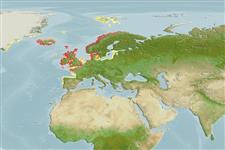>
Eupercaria/misc (Various families in series Eupercaria) >
Labridae (Wrasses)
Etymology: Centrolabrus: Greek, kentron = sting + Greek, labros = furious (Ref. 45335).
More on author: Linnaeus.
Environment: milieu / climate zone / depth range / distribution range
Écologie
marin récifal; profondeur 3 - 10 m (Ref. 130218). Temperate; 80°N - 33°N, 47°W - 25°E
Eastern Atlantic: Norway to Portugal; also eastern Greenland.
Taille / Poids / Âge
Maturity: Lm ? range ? - ? cm
Max length : 18.0 cm TL mâle / non sexé; (Ref. 4645); common length : 12.0 cm TL mâle / non sexé; (Ref. 3397); âge max. reporté: 6 années (Ref. 4792)
Épines dorsales (Total) : 18 - 20; Rayons mous dorsaux (Total) : 5 - 7; Épines anales: 4 - 6; Rayons mous anaux: 6 - 8. Snout with 5-10 pores. Upper lip with 5-7 folds. Rows of scales on cheek 3-5, on inter-operculum 2 (7-11) scales, on temporo-occipital surface 5-8. Vertebrae 32-34. Preoperculum edge serrated. One row of scales on base of soft part of dorsal and anal fins (Ref. 232). No black spots on the body or fins (Ref. 35388).
Adults are found in eel-grass beds near rocks. Feed on small invertebrates (Ref. 4742). Eggs are laid in the summer in a seaweed nest (Ref. 35388). Males grow faster than females (Ref. 4792). Oviparous, distinct pairing during breeding (Ref. 205). Used in salmon culture as cleaner fish (Helmut Tethmeyer, pers. comm.).
Life cycle and mating behavior
Maturité | Reproduction | Frai | Œufs | Fécondité | Larves
Oviparous, distinct pairing during breeding (Ref. 205). Males build dish shaped nests and guard the eggs (Ref. 205). Also Ref. 103751.
Quignard, J.-P. and A. Pras, 1986. Labridae. p. 919-942. In P.J.P. Whitehead, M.-L. Bauchot, J.-C. Hureau, J. Nielsen and E. Tortonese (eds.) Fishes of the north-eastern Atlantic and the Mediterranean. UNESCO, Paris. Vol. 2. (Ref. 4742)
Statut dans la liste rouge de l'IUCN (Ref. 130435: Version 2024-1)
Menace pour l'homme
Harmless
Utilisations par l'homme
Pêcheries: sans intérêt; Aquarium: Aquariums publics
Outils
Articles particuliers
Télécharger en XML
Sources Internet
Estimates based on models
Preferred temperature (Ref.
123201): 8.9 - 13, mean 10.7 °C (based on 352 cells).
Phylogenetic diversity index (Ref.
82804): PD
50 = 0.7500 [Uniqueness, from 0.5 = low to 2.0 = high].
Bayesian length-weight: a=0.00741 (0.00462 - 0.01191), b=3.09 (2.96 - 3.22), in cm total length, based on LWR estimates for this species & (Sub)family-body (Ref.
93245).
Niveau trophique (Ref.
69278): 3.5 ±0.50 se; based on food items.
Résilience (Ref.
120179): Milieu, temps minimum de doublement de population : 1,4 à 4,4 années (K=0.69-0.81; tmax=6).
Fishing Vulnerability (Ref.
59153): Low vulnerability (20 of 100).
Nutrients (Ref.
124155): Calcium = 29.2 [12.2, 57.3] mg/100g; Iron = 0.262 [0.139, 0.577] mg/100g; Protein = 18.9 [15.9, 21.1] %; Omega3 = 0.392 [0.200, 0.784] g/100g; Selenium = 5.61 [2.42, 13.29] μg/100g; VitaminA = 75.5 [17.9, 378.5] μg/100g; Zinc = 0.799 [0.513, 1.451] mg/100g (wet weight);
